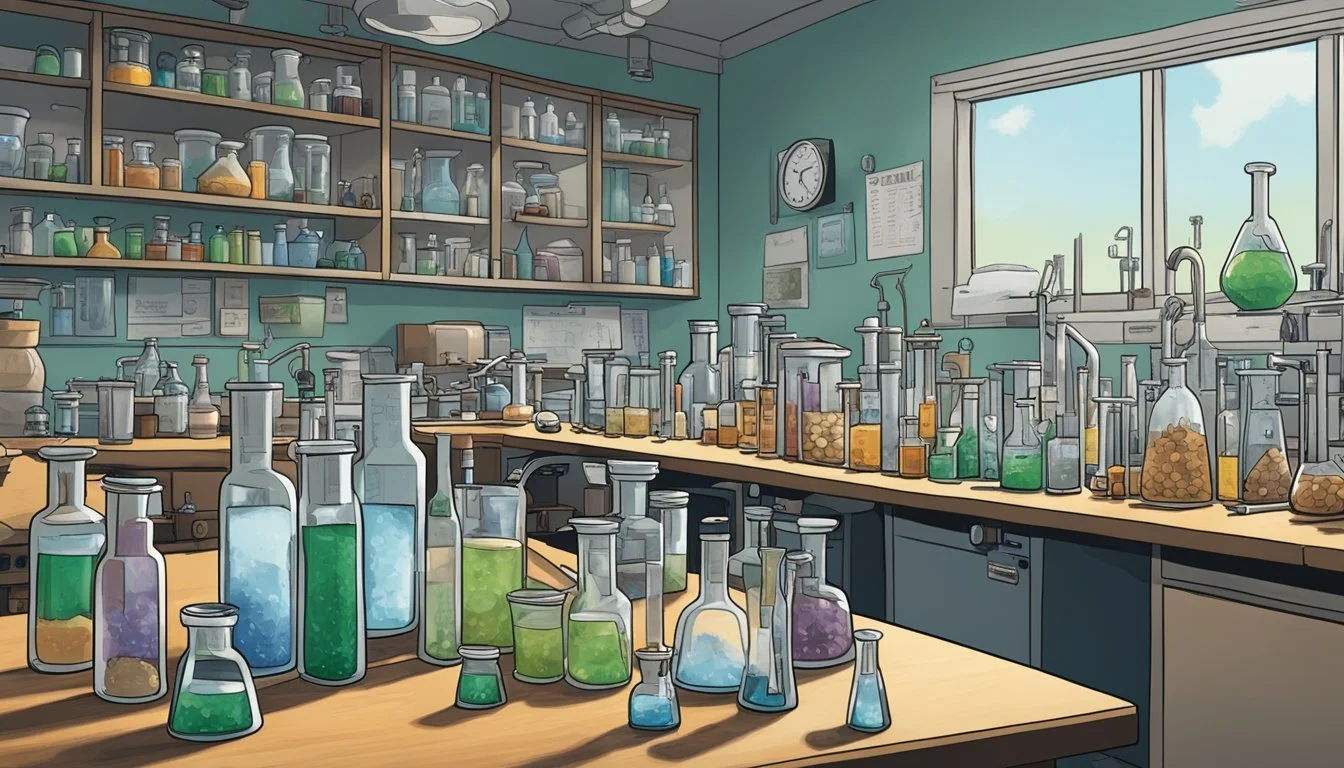The Significance of Walt's Birthday
A Year of Transformation Marks Pivotal Turning Point
Walter White's birthday serves as a pivotal marker in Breaking Bad, highlighting his dramatic transformation over the course of a single year. From a mild-mannered high school chemistry teacher to a feared drug lord, Walt's journey is encapsulated in the stark contrast between his 50th and 51st birthdays.
The celebration of Walt's 51st birthday reveals the profound changes in his life, relationships, and moral compass. His family's joyful acknowledgment of his 50th birthday stands in sharp contrast to the somber atmosphere of his 51st, where only Jesse Pinkman recognizes the occasion with a gift. This shift symbolizes Walt's increasing isolation from his former life and his deeper immersion into the criminal underworld.
The Tag Heuer Monaco watch, given to Walt by Jesse, becomes a powerful symbol of his new identity. This luxury timepiece represents Walt's transformation from an ordinary citizen to a criminal mastermind, marking both his newfound status and the ticking clock of his remaining time. As Walt embraces his Heisenberg persona, each birthday serves as a reminder of how far he has come and how much he has lost in his pursuit of power and legacy.
Walter White's Journey
Walter White's transformation from a mild-mannered chemistry teacher to the notorious drug lord Heisenberg is at the heart of Breaking Bad. His journey explores complex themes of identity, morality, and the consequences of one's choices.
Cancer Diagnosis
Walter White's life changes dramatically when he receives a terminal lung cancer diagnosis on his 50th birthday. This shocking news forces him to confront his mortality and reassess his priorities. Faced with mounting medical bills and a desire to provide for his family after his death, Walt makes the fateful decision to use his chemistry expertise to produce methamphetamine.
The cancer diagnosis serves as the catalyst for Walt's descent into the criminal underworld. It pushes him to take risks he never would have considered before, setting him on a path that will ultimately transform him into a different person entirely.
From Chemistry Teacher to Heisenberg
Walt's transition from high school teacher to drug manufacturer is rapid and jarring. He partners with Jesse Pinkman, a former student, to cook meth in a mobile lab. Walt's superior chemistry knowledge allows them to produce a high-quality product that quickly gains notoriety.
As he delves deeper into the drug trade, Walt adopts the alias "Heisenberg" and begins to shed his former identity. He becomes more confident, ruthless, and willing to do whatever it takes to succeed in his new enterprise.
Walt's skills as a chemist and his growing business acumen lead to the expansion of his operation. He moves from small-scale production to industrial-level manufacturing, establishing himself as a major player in the Southwest's drug trade.
Identity and Moral Ambiguity
Walt's journey is marked by a gradual erosion of his moral compass. Initially, he justifies his actions as necessary for his family's financial security. As time passes, his motivations become more self-serving and his actions increasingly ruthless.
This shift in Walt's character raises questions about identity and the nature of good and evil. Is Walt still the same person he was before his cancer diagnosis? Or has he fundamentally changed?
The show explores the blurred lines between Walt's roles as a family man, teacher, and criminal. His decisions often have dire consequences for those around him, yet he continues to rationalize his choices.
Alter Ego and Duality
Heisenberg represents more than just an alias for Walt - it becomes an alter ego that embodies his darker impulses. This duality is a central theme in Breaking Bad, as Walt struggles to reconcile his two identities.
The Heisenberg persona allows Walt to act with a confidence and aggression that was previously foreign to him. He uses this alter ego as a shield, separating his criminal activities from his "real" life.
As the series progresses, the line between Walt and Heisenberg becomes increasingly blurred. The transformation is reflected in Walt's appearance, behavior, and relationships with others. By the end, it's unclear whether Walt can truly separate himself from the monster he's become.
Narrative Techniques
Breaking Bad employs sophisticated narrative techniques to enhance its storytelling. These methods add depth to Walt's character development and the show's thematic exploration.
Non-Linear Storytelling and Flash-Forwards
Breaking Bad utilizes non-linear storytelling to great effect. The series opens with a flash-forward of Walt's 50th birthday, then jumps back to show the events leading up to that point. This technique creates intrigue and foreshadows Walt's transformation.
Flash-forwards appear throughout the series, most notably in the cold opens of season 2. These glimpses into future events build tension and keep viewers engaged. The pink teddy bear motif, seen in these flash-forwards, becomes a powerful symbol of the consequences of Walt's actions.
The show's timeline often loops back on itself, revealing new perspectives on past events. This narrative structure mirrors Walt's complex journey and the ripple effects of his choices.
Symbolism and Thematic Elements
Breaking Bad is rich with symbolism that underscores its themes. Walt's glasses and Heisenberg hat serve as visual cues for his shifting identity. The recurring use of the color green symbolizes greed and the corrupting influence of money.
Chemical elements play a significant role in the show's symbolism. The opening credits feature the periodic table, linking Walt's scientific background to his criminal activities. The purity of Walt's methamphetamine becomes a metaphor for his expertise and the addictive nature of power.
The show explores themes of change and decay through visual motifs. Time-lapse sequences of Albuquerque's landscape reflect the passage of time and the gradual erosion of Walt's moral character.
Character Dynamics
Walter White's birthday marks a turning point in his relationships with key figures. His interactions with family members, criminal associates, and adversaries shift dramatically as he embraces his new identity.
Walt Jr. and Family Relationships
Walt's transformation strains his bond with his son, Walt Jr. Initially close, their relationship becomes distant as Walt's secrets mount. Walt Jr. struggles to reconcile the father he knew with the man he's becoming.
Family dinners grow tense. Walt misses important events. His absences and lies create a rift with Skyler, impacting the entire family dynamic.
Walt tries to maintain a facade of normalcy, but his changed priorities become apparent. His attempts to connect with Walt Jr. feel forced and hollow as his double life takes precedence.
Jesse Pinkman: Partner and Protégé
Jesse evolves from Walt's former student to his reluctant partner in crime. Their relationship is complex, alternating between mentor-protégé and adversaries.
Walt manipulates Jesse, exploiting his vulnerabilities. Yet he also protects him at times, displaying a twisted form of paternal care.
Their dynamic shifts as Jesse gains confidence and skill. Power struggles emerge as Jesse questions Walt's decisions and motives.
Walt's birthday highlights the stark contrast between his family life and criminal partnership. Jesse's gift of an expensive watch symbolizes their complicated bond.
Gus Fring and Power Struggles
Walt's encounter with Gus Fring marks a pivotal moment in his transformation. Gus represents a level of power and control Walt aspires to attain.
Their relationship is a chess match of strategy and manipulation. Walt's birthday coincides with his growing ambition to challenge Gus's authority.
Gus's calculated demeanor contrasts with Walt's increasingly erratic behavior. Their power struggle escalates, with each trying to outmaneuver the other.
Walt's desire to prove himself against Gus drives many of his decisions. This rivalry pushes Walt further into darkness, cementing his transformation into Heisenberg.
Breaking Bad's Cultural Impact
Breaking Bad revolutionized television drama, setting new standards for storytelling and character development. Its influence reshaped audience expectations and inspired a wave of high-quality programming.
Legacy and Influence
Breaking Bad's impact on the television landscape cannot be overstated. The show's creator, Vince Gilligan, crafted a narrative that captivated audiences worldwide. Its intricate plotting and morally complex characters redefined what was possible in serialized drama.
The series sparked numerous discussions about morality, consequence, and the nature of evil. It influenced subsequent TV dramas, raising the bar for writing, acting, and production values.
Breaking Bad's success also paved the way for more ambitious and risky storytelling on cable networks. It demonstrated that audiences were hungry for complex, challenging content.
AMC and Televised Tragedy
AMC's decision to greenlight Breaking Bad marked a turning point for the network. The show's critical acclaim and growing viewership transformed AMC from a minor player into a powerhouse of original programming.
Breaking Bad's exploration of tragedy through Walter White's descent into villainy resonated deeply with viewers. It tapped into themes of American ambition and the dark side of the pursuit of success.
The series' unflinching portrayal of consequences set it apart from other crime dramas. Each decision made by the characters had far-reaching impacts, creating a sense of realism and tension.
AMC's willingness to support Gilligan's vision encouraged other networks to take chances on unconventional ideas. This shift led to a renaissance in television drama, with more networks investing in high-quality, creator-driven series.
Cinematic Elements
Breaking Bad's visual storytelling employs distinctive cinematography and symbolic imagery to convey Walter White's transformation. The show's cinematic choices reinforce themes of change and moral decay.
Albuquerque: A Character in Itself
Albuquerque's stark desert landscape serves as a backdrop for Walt's journey. The city's wide-open spaces and harsh sunlight create a sense of isolation and exposure.
Time-lapse shots of clouds racing across the sky emphasize the passage of time and Walt's rapid descent into criminality. The contrast between the bright, arid exteriors and dark, shadowy interiors mirrors Walt's dual nature.
Aerial shots showcase Albuquerque's sprawling suburbs, highlighting the mundane world Walt seeks to escape. The imposing Sandia Mountains loom in the background, a constant reminder of nature's indifference to human affairs.
Iconography and Costuming
Walt's appearance evolves alongside his character. His initial wardrobe of beige khakis and pastel shirts reflects his bland, unremarkable life. As Heisenberg emerges, Walt adopts darker colors and his iconic pork pie hat.
The show's most memorable visual motif is Walt in his tighty-whities. This vulnerable image contrasts sharply with his eventual ruthless persona. The underwear becomes a symbol of Walt's initial desperation and loss of dignity.
Walt's glasses serve as a metaphorical lens through which he views the world. Their presence or absence in scenes can indicate shifts in his perspective or decision-making.
The Transformation of Walter White
Walter White's journey from mild-mannered chemistry teacher to ruthless drug kingpin is central to Breaking Bad's narrative. His character evolution unfolds through a series of pivotal moments and symbolic objects that mark his descent into the criminal underworld.
Pivotal Moments in Character Evolution
Walt's 50th birthday marks the beginning of his transformation. His cancer diagnosis acts as a catalyst, pushing him to cook meth to secure his family's financial future. The decision to let Jane die represents a turning point, showcasing Walt's growing ruthlessness.
His confrontation with Tuco demonstrates his willingness to use violence. The explosion at Gus Fring's nursing home cements Walt's position as a major player in the drug trade.
Each of these moments peels away layers of Walt's former self, revealing the Heisenberg persona underneath. His actions become increasingly calculated and morally ambiguous as the series progresses.
The Role of the Luxury Watch
The Tag Heuer Monaco watch serves as a potent symbol of Walt's transformation. Given to him as a birthday gift, it represents his newfound wealth and power in the drug world.
The watch contrasts sharply with Walt's humble beginnings, highlighting how far he's come. Its presence on his wrist serves as a constant reminder of his criminal success.
In later episodes, the watch becomes a point of conflict. Walt's refusal to part with it, despite the danger it poses, illustrates his attachment to his Heisenberg identity and the power it brings.
The Meth Trade
Walter White's entry into the methamphetamine business marks a pivotal turn in his life. His chemistry expertise enables him to produce a superior product, quickly establishing his criminal identity in Albuquerque's drug trade.
Drug Kingpin Operations
Walt's meth operation grows from small-scale production to a major enterprise. He partners with former student Jesse Pinkman, leveraging Jesse's street connections. Their signature "blue meth" gains notoriety for its purity and potency.
Walt adopts the pseudonym "Heisenberg" to protect his identity. He expands distribution networks, forming alliances with local dealers like Tuco Salamanca. These partnerships prove volatile, often leading to violent confrontations.
As production scales up, Walt seeks larger distribution channels. He negotiates with cartels and establishes a sophisticated money laundering system through a car wash business.
Criminal Tactics and Evidence
Walt employs his scientific knowledge to stay ahead of law enforcement. He devises ingenious methods to conceal evidence, such as dissolving bodies in hydrofluoric acid.
His brother-in-law Hank Schrader, a DEA agent, unwittingly investigates Walt's activities. This creates intense suspense as Walt must constantly cover his tracks.
Walt's criminal tactics evolve from defensive to offensive. He orchestrates assassinations and manipulates rival gangs to eliminate threats. His willingness to use extreme measures solidifies his position in the drug trade.
Despite his precautions, Walt leaves traces of evidence. Discarded lab equipment, financial records, and witness testimonies accumulate, gradually tightening the net around his operation.
Scientific References in Breaking Bad
Breaking Bad incorporates numerous scientific concepts and references throughout its narrative. These elements add depth and authenticity to the show's portrayal of Walter White's journey from chemistry teacher to methamphetamine manufacturer.
Chemistry and the Manufacture of Crystal Meth
Walter White's background as a chemistry teacher plays a crucial role in his illicit activities. The show accurately depicts various chemical processes involved in manufacturing crystal meth.
White's expertise allows him to produce a highly pure product using the P2P method. This process involves phenylacetic acid and methylamine as key ingredients.
The series also features other chemistry-related plot points. One notable example is Walt's use of fulminated mercury as an explosive device. This compound, while potentially dangerous, is indeed capable of detonating under certain conditions.
Easter Eggs: Quantum Physics and Nobel Prize
Breaking Bad includes subtle nods to advanced scientific concepts beyond chemistry. Quantum physics receives a brief mention in a conversation between Walt and Jesse.
The show references the Nobel Prize in Chemistry multiple times. Walt's former colleagues win the prestigious award for their groundbreaking research.
These scientific Easter eggs serve to highlight Walt's intellectual prowess and reinforce the theme of wasted potential. They also provide engaging details for scientifically-inclined viewers to appreciate.
Exploring Themes of Consequence
Walt's birthday marks a pivotal point in his journey, highlighting the far-reaching effects of his choices. His transformation blurs the lines between good and evil, leading to widespread destruction.
The Convergence of Hero and Villain
Walt's actions blur the distinction between hero and villain. His initial noble intentions to provide for his family gradually give way to ego and power-seeking behavior. This shift challenges viewers' moral compass, forcing them to question their sympathies.
Walt's duality becomes more pronounced as he embraces his Heisenberg persona. The mild-mannered teacher and ruthless drug lord coexist, showcasing the complexity of human nature.
His birthday gift, a Tag Heuer Monaco watch, symbolizes this transformation. It represents his newfound status and the respect he commands in the criminal world.
Destruction and Fallout
Walt's decisions leave a trail of destruction in their wake. His actions impact not only his immediate family but also extend to a wider circle of individuals and communities.
The consequences of his choices ripple outward:
Strained family relationships
Loss of innocent lives
Corruption of law enforcement
Destabilization of local drug markets
Walt's legacy becomes tainted by violence and moral compromise. His initial goal of securing his family's future ironically puts them at greater risk.
The fallout from his actions continues long after his birthday, shaping the lives of those around him in unforeseen ways. This underscores the theme that no action, however well-intentioned, is without consequences.







